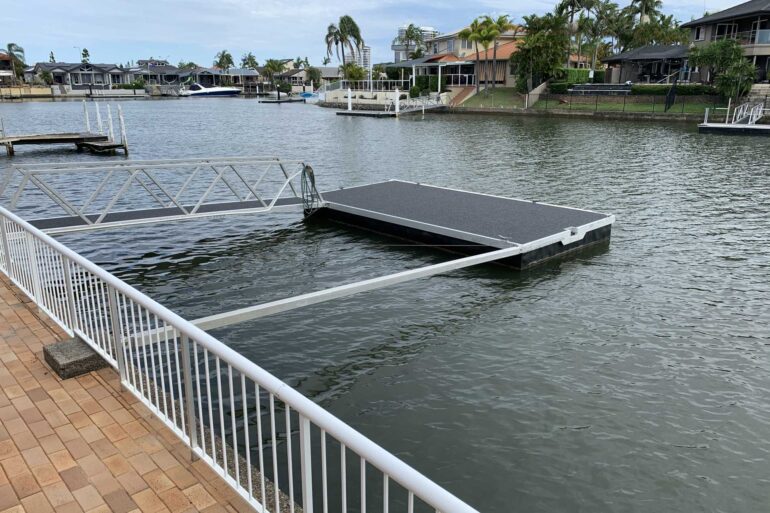
If you’re like many waterfront homeowners, you may be in the market for a pontoon dock. Pontoons are growing in popularity, and for good reason—they offer a great way to get out on the water without having to rely on a boat launch and provide a stable place to moor your boat.
If you’re considering a pontoon, one of the questions you’ll need to answer is which type of pontoon is right for you? There are generally three types of pontoons to choose from – strut arm pontoons, cable pontoons and piled pontoons.
Before you buy a pontoon, it’s important to consider the pros and cons of different types of docks. In this blog post, we’ll take a look at strut arm pontoons and discuss the pros and cons of this type of dock. Let’s get started!
What is a Strut Arm Pontoon?
A Strut Arm Pontoon is a specialised type of floating dock that is commonly used in marinas and other waterfront applications. The dock consists of a mooring block, pontoon and a gangway, connected by a series of steel struts.
The gangway is the walkway that allows you to move from the shore to the floating dock. A concrete mooring block anchors the strut to the shore, similar to a boat mooring. The arm is a lightweight aluminium strut (arm) that connects the shoreline to the dock. The cables are made from stainless steel and cross over in an X pattern.
The pontoon and gangway provide buoyancy and stability, while the struts help to transfer wave energy away from the dock structure.
In addition, the wide base of the dock helps to resist wind forces, making it ideal for use in exposed waterfront locations.
What are the advantages of a Strut Arm Pontoon?
Strut arm pontoons are popular because they can be easily installed and removed and offer various benefits.
For example, they are ideal for calm waters and waters with restricted use of piles. They are also making a more cost-effective option than piled pontoons. Additionally, because they are pile-free, they are ideal for locations with deep or rocky seabeds. They are also ideal for properties with a short quay line, where a shorter pontoon is required. Finally, strut arm pontoons are easier to maintain than other types of pontoons, as the metal struts can be quickly replaced if they become damaged.
Advantages of a Strut Arm Pontoon compared to other pontoons
As mentioned, there are three main types of pontoons: strut arm, cable, and piled. Each type has its own advantages and disadvantages.
- Compared to cable pontoons, strut pontoons are similar in price and construction complexity. They are, however, a little more robust than cable pontoons and will therefore fare better in stronger conditions.
- Compared to piled pontoons, strut pontoons are much more affordable. They are also easier and quicker to install.
What are the disadvantages of a Strut Arm Pontoon?
There are several disadvantages of strut arm pontoons.
First, they are not as suitable for rough waters as other types of pontoons. Second, they are not as robust or durable as piled pontoons, meaning they are more likely to be damaged in a storm or rougher water.
Third, they are not suitable for long pontoons, so if you have a large boat, you will need to use a different type of pontoon. Finally, the strut and steel cables that span over the region infringe on any beach in the foreground, which can be unsightly and consume all of your beachfront.
While there are some drawbacks to using a strut arm pontoon, it can still be a good option for those who live in an area with calm waters.
Disadvantages of a Strut Arm Pontoon compared to other pontoons
While strut arm pontoons fare well on their own, compared to cable and piled pontoons, there are some additional disadvantages to consider.
- Compared to cable pontoons, strut pontoons are marginally more expensive.
- Compared to piled pontoons, strut pontoons are less stable, meaning they are more likely to be damaged in a storm or high winds. Additionally, they are not as durable and are more likely to require maintenance in such conditions.
Is a Strut Arm Pontoon Right for you?
Now that you know more about strut arm pontoons, it’s time to decide if this type of pontoon is right for you. If you live in an area with calm waters and you’re looking for a cost-effective and easy-to-maintain pontoon, a strut arm pontoon could be a good option.
However, if you have a large boat or you live in an area with rough waters, you may want to consider another type of pontoon.
Conclusion
Pontoons come in various types, each with its own pros and cons. In this article, we have looked at the pros and cons of strut arm pontoons.
While this type of pontoon is less expensive than other options, it is not as stable or durable and unsuitable for use in rough waters. However, strut arm pontoons could be a good option if you live in an area with calm waters and you’re looking for a cheaper option.
If you have questions about whether a strut arm pontoon is right for you, please call Micks Marine Maintenance. We can assess your specific needs and make a recommendation based on your budget and location.
Please visit our Strut Pontoons page for more information on strut arm pontoons.